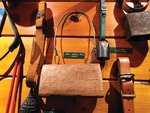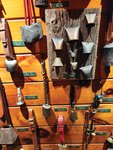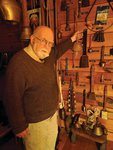


Dr. James Diamond was 7 years old when he became enchanted with the sound of animal bells.
“I loved the gentle music that came from sheep wearing bells on a neighboring farm. It was so peaceful and charming,” he said.
It was a sound he would hear often while traveling to 59 countries as an agricultural and extension educator for the United Nations and United States Agency for International Development and during his posting to Tchad (formerly Chad) while in the Peace Corps. His passion for the bells would inspire him to study their history and farm practicality and to bring them home where they would form his international collection of domestic animal bells.
Growing up on a farm in Western Pennsylvania, animal bells were a part of his life. His father gave him his first bell – a cow bell – when he was 8 years old. His collection took root when he found vintage sleigh bells in his father-in-law’s Doylestown barn.
His bells have hung around the necks of 13 kinds of animals: sheep, cows, mules, donkeys, elephants, water buffalo, llamas, yaks, horses, dogs, cats and turkeys. He also has a bear warning bell that was used in Canada to alert bears that hikers were nearby.
Today his 88 bells from 30 countries are mounted on a wall in his Ottsville home. The bells inspired him to write a book, “Domestic Animal Bells from Around the World.”
Now that he is retired from his position as Dean of Agriculture and Environmental Sciences at Delaware Valley University in Doylestown, he has time to offer presentations on the sound, history and importance of domestic animal bells. He has spoken to and rung his bells more than 100 times for churches, women’s groups, local granges, 4-H clubs and other community groups throughout the state.
Diamond said we rely on animal bells more than we realize. “In some parts of Pennsylvania farmers use bells on their domestic animals so they aren’t mistaken for deer during hunting season,” he said.
In Third World countries the sound of the bells on horses pulling a wagon or plow will reduce the boredom of the driver, he said.
Diamond raised Suffolk sheep at one time and knows that for a shepherd, the need for bells is crucial. “When you have a flock of sheep, you know where they are at any time by the sound of the bells. You know if they are laying down, running or walking by the cadence of the bells,” he said.
Bells are made from metal and wood. At times they are made from cast-off materials, such as a horse bell Diamond acquired in Ethiopia. Instead of having a clapper like most bells, this one was composed of six U-shaped pieces of steel that clanged against each other when the horse walked, trotted or galloped.
Diamond likes to talk about turkey bells, which were used after American birds were crossbred with European varieties in the mid-19th century. This created a heavier, meatier bird that couldn’t quickly fly away from predators. To protect the turkeys, farmers hung bells around their necks, ensuring they could hear any sounds from the birds if they were in distress.
His collection includes a goat bell from the Republic of Mali, where young boys were responsible for herds and were punished if a goat wandered away. Bells helped them to know where they were at all times.
He owns a yak bell from Tibet where the clapper is made from the horn of a yak, a Russian cow bell and a donkey bell from Iran with a handmade spike for a clapper.
Each bell has a different sound, he explains, and they can ring, chime, clack, clunk or toll. The important thing is that the owner of the animals knows which sound he should be hearing.
A replica of a Korean water buffalo bell in his collection has an etching inside. Research taught him that it represented the innocent sound of a young girl calling for her mother. Legend said that a village priest once sacrificed a child by throwing her into molten metal that was used to make bells. When it rings, the bell should sound like a child calling, “Mama, Mama,” in memory of the child who was sacrificed.
Diamond collected most of his bells himself, but some have been gifts from friends. Among the most unusual is a Saudia Arabian camel bell given to him by a student of his at Penn State University who was the nephew of Saddam Hussein; he had defected to America in 1978.
Diamond is working on making his collection available to the public, possibly on display in a museum or at a university. In the meantime, groups can contact him about a presentation.
Join our readers whose generous donations are making it possible for you to read our news coverage. Help keep local journalism alive and our community strong. Donate today.